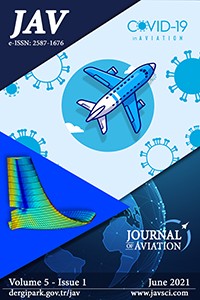Abstract
Akıllı yangın söndürme mühimmatı (AYSM) yangınlarla havadan mücadele yöntemlerinde kullanılabilecek, yeni ve etkili bir üründür. Bu ürün NATO üyesi ülkelerin envanterinde bulunan bir harp mühimmatı olan MK-82 (havadan yere genel maksat bombası) tip mühimmatın tasarımına benzer tasarıma sahiptir. Tasarım ölçülerinin var olan bir harp mühimmatına benzemesi onu hava araçları üzerinde herhangi bir iyileştirme veya değiştirme yapmadan doğrudan hava aracına yükleme imkânı vermektedir. Bu çalışmanın amacı, insansız bir hava aracına yüklü mühimmatın, araca ait maksimum hız koşullarında ortaya çıkaracağı sürükleme katsayısının tespitidir. Hava aracının ulaşacağı maksimum hız değerinde AYSM’nin gövdesi üzerinde ortaya çıkacak basınç ve hız profillerinin belirlenerek görselleştirilmesi amaçlanmıştır. Korunum denklemleri farklı türbülans modelleri kullanılarak sonlu elemanlar esasına dayalı olan Ansys Fluent yazılımı yardımıyla çözülmüştür. Bilgisayar ortamında sanal bir rüzgâr tüneli kurulmuş farklı y+ değerleri kullanılarak mühimmata ait ağ optimizasyonu yapılmıştır. Türbülans modelleri olarak SpalartAllmaras (S-A) modeli, standart k-ε modeli ve SST k-ω türbülans modeli kullanılmıştır. Bulunan sonuçlar MK-82 tip genel maksat bombasına ait literatür verileri ile karşılaştırılarak doğrulama yapılmıştır. Kullanılan türbülans modellerinden SST k-ω türbülans modeli en doğru sonucu vermiştir. Bu model kullanılarak maksimum uçuş hızı için mühimmat gövdesi üzerinde meydana gelebilecek basınç ve hız profilleri elde edilmiştir. Bu profiller ileride yapılacak yapısal statik ve dinamik analizleri belirlemek amacıyla kullanılacaktır
Keywords
Yangın Söndürme Mühimmatı Akıllı Mühimmat Hesaplamalı Akışkanlar Dinamiği (HAD) Türbülans Modelleri Sürükleme Katsayısı
References
- European Commission, Directorate-General for Research and Innovation, “Forest Fires- Sparking fire smart policies in the EU,” Publications Office of the European Union, Luxembourg 2018.
- R. Hall, “Essentials of Fire Fighting,” Fire Protection Publications, Fourth Edition. Stillwater, OK, 1998.
- A. Küçükosmanoğlu, “Türkiye Orman Yangınlarına Ait Bazı Verilerin Değerlendirilmesi,” İstanbul Üniversitesi Orman Fakültesi Dergisi, 43, 94, 1993.
- M. Pulicinski, J. Gould, “The Effectiveness and Efficiency of Aerial Firefighting in Australia,” (Technical Report Number A0701), University of Melbourne, Department of Environment and Conservation, Melbourne, Australia 2007.
- R. Alder, “Fighting Bush fires from the air”, Paper presented at the Conference of the Institute of Fire Engineers, Adelaide, 1990.
- S. Dowling, “The jaw-dropping missions of fire-fighting pilots”, https://www.bbc.com/future/article/20150821-the-jaw-dropping-missions-of-fire-fighting-pilots. [Erişim Tarihi: 19-Mart-2021].
- V. K. Korenkov, “ASP-500 Fire-extinguishing Air System”, Revue Militaire Suisse, 149, 32, 2004.
- Z. Lei, China Daily , “Chinese rockets aimed at high-rise fires”, , https://www.chinadaily.com.cn/china/2017-02/14/content_28190425.htm. [Erişim Tarihi: 19-Mart-2021].
- A. H. Purcell, “Bombing' Forest Fires: A Proposed Technology,” Environmental Conservation, 11(2), 183-183, 1984.
- H. Houghton, “F1 in Schools Car Design Simulation Tutorial,” Autodesk Flow Design, 5, 2014.
- S. Geçim, E. Pulat, M. K. İşman ve A. E. Etemoğlu, “Çarpan dikdörtgen bir hava jetinde türbülans modellerinin karşılaştırılması ve ilgili parametrelerin ısı transferine etkileri,” Uludağ Üniversitesi Mühendislik-Mimarlık Fakültesi Dergisi, Cilt 13, Sayı 2, 2008.
- FLUENT, Fluent User’s Guide, Lebanon, NH: Fluent Incorporated, 2006.
- B.E. Launder, D.B. Spalding, “The numerical computation of turbulent flows,” Computer Methods in Applied Mechanics and Engineering, Volume 3, Issue 2, 1974, 269-289.
- F. R. Menter, “Two-equation eddy-viscosity turbulence models for engineering applications,” AIAA Journal, 32, 1598–1605, 1994.
- CFD Online, “CFD-Online.com.” https://www.cfd-online.com/Wiki/SST_k-omega_model. [Erişim Tarihi: 19-Mart-2021].
- D. C. Wilcox, “Reassessment of the scale-determining equation for advanced turbulence models,” AIAA Journal, 26, 1299–1310, 1998.
- Ansys Fluent 14.0: Theory Guide, ANSYS, Inc., 275 Technology Drive Canonsburg, PA 15317, 2011.
- L. V. Krishnamoorthy, D. R. Kirk, R. Glass, “Aerodynamic Database for the Mk 82 General Purpose Low Drag Bomb,” DSTO-TR-0554, Canberra (Australia), Defence Science and Technology Organization, 1997.
Abstract
References
- European Commission, Directorate-General for Research and Innovation, “Forest Fires- Sparking fire smart policies in the EU,” Publications Office of the European Union, Luxembourg 2018.
- R. Hall, “Essentials of Fire Fighting,” Fire Protection Publications, Fourth Edition. Stillwater, OK, 1998.
- A. Küçükosmanoğlu, “Türkiye Orman Yangınlarına Ait Bazı Verilerin Değerlendirilmesi,” İstanbul Üniversitesi Orman Fakültesi Dergisi, 43, 94, 1993.
- M. Pulicinski, J. Gould, “The Effectiveness and Efficiency of Aerial Firefighting in Australia,” (Technical Report Number A0701), University of Melbourne, Department of Environment and Conservation, Melbourne, Australia 2007.
- R. Alder, “Fighting Bush fires from the air”, Paper presented at the Conference of the Institute of Fire Engineers, Adelaide, 1990.
- S. Dowling, “The jaw-dropping missions of fire-fighting pilots”, https://www.bbc.com/future/article/20150821-the-jaw-dropping-missions-of-fire-fighting-pilots. [Erişim Tarihi: 19-Mart-2021].
- V. K. Korenkov, “ASP-500 Fire-extinguishing Air System”, Revue Militaire Suisse, 149, 32, 2004.
- Z. Lei, China Daily , “Chinese rockets aimed at high-rise fires”, , https://www.chinadaily.com.cn/china/2017-02/14/content_28190425.htm. [Erişim Tarihi: 19-Mart-2021].
- A. H. Purcell, “Bombing' Forest Fires: A Proposed Technology,” Environmental Conservation, 11(2), 183-183, 1984.
- H. Houghton, “F1 in Schools Car Design Simulation Tutorial,” Autodesk Flow Design, 5, 2014.
- S. Geçim, E. Pulat, M. K. İşman ve A. E. Etemoğlu, “Çarpan dikdörtgen bir hava jetinde türbülans modellerinin karşılaştırılması ve ilgili parametrelerin ısı transferine etkileri,” Uludağ Üniversitesi Mühendislik-Mimarlık Fakültesi Dergisi, Cilt 13, Sayı 2, 2008.
- FLUENT, Fluent User’s Guide, Lebanon, NH: Fluent Incorporated, 2006.
- B.E. Launder, D.B. Spalding, “The numerical computation of turbulent flows,” Computer Methods in Applied Mechanics and Engineering, Volume 3, Issue 2, 1974, 269-289.
- F. R. Menter, “Two-equation eddy-viscosity turbulence models for engineering applications,” AIAA Journal, 32, 1598–1605, 1994.
- CFD Online, “CFD-Online.com.” https://www.cfd-online.com/Wiki/SST_k-omega_model. [Erişim Tarihi: 19-Mart-2021].
- D. C. Wilcox, “Reassessment of the scale-determining equation for advanced turbulence models,” AIAA Journal, 26, 1299–1310, 1998.
- Ansys Fluent 14.0: Theory Guide, ANSYS, Inc., 275 Technology Drive Canonsburg, PA 15317, 2011.
- L. V. Krishnamoorthy, D. R. Kirk, R. Glass, “Aerodynamic Database for the Mk 82 General Purpose Low Drag Bomb,” DSTO-TR-0554, Canberra (Australia), Defence Science and Technology Organization, 1997.
Details
| Primary Language | Turkish |
|---|---|
| Subjects | Aerospace Engineering |
| Journal Section | Research Articles |
| Authors | |
| Publication Date | June 30, 2021 |
| Submission Date | March 22, 2021 |
| Acceptance Date | June 29, 2021 |
| Published in Issue | Year 2021 Volume: 5 Issue: 1 |
Journal of Aviation - JAV |
This journal is licenced under a Creative Commons Attiribution-NonCommerical 4.0 İnternational Licence


